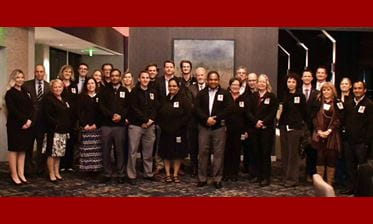Funded by the National Institutes of Health NIDDK, the NIDDK Diabetic Foot Consortium, which began in 2018, is the first multicenter network to study diabetic foot ulcers, a complication of diabetes and the leading cause of lower limb amputation in the United States. Members across six research institutions, including Indiana University School of Medicine, are developing clinical trials to test how to improve diabetic wound healing and prevent amputations.
“I want to thank Dr. Jones from the NIDDK for being here for the consortium,” said Tatiana Foroud, PhD, executive associate dean for Research Affairs at Indiana University School of Medicine and chair of the Department of Medical and Molecular Genetics, in her opening remarks. “I also want to recognize the IU School of Medicine and IU Health for seeing the importance of the Diabetic Foot Consortium. We recognize the importance of the care of patients and the need to reduce complications.”
Currently, more than 34 million people in the United States (10 percent of the U.S. population) have diabetes. Every year, approximately 100,000 Americans with diabetes will lose part of their lower limb because a foot ulcer becomes infected or does not heal. According to the Centers for Disease Control and Prevention, in 2016, 5.6 of 1,000 adults with diabetes who were discharged from the hospital, had lower-extremity amputations.

Indiana is among 10 states in the country with the highest amputation rates. According to Dartmouth Atlas, the amputation rate for Hoosiers in 2015 was .69 per 1,000 Medicare enrollees. Counties in the western part of Indiana had higher rates of amputation.
The IU Health Wound Comprehensive Care Center at IU Health Methodist Hospital opened in 2020 with a mission to provide primary wound care, specialty care and access to clinical research trials, with the goal of salvaging more limbs to provide better outcomes and quality of life to patients.
“I’m delighted that the first offsite meeting is happening here in Indianapolis because the Indiana numbers for amputation are worse than the national average, and we see that as a huge opportunity to bring and improve the level of care—such that amputation rates within this state and beyond in the country will go down,” said Chandan K. Sen, PhD, associate vice president for research at Indiana University and director of the ICRME. “The NIH is very interested to see that the science we’re doing is applicable to make a difference in people’s health care. To make this happen, IU Health and IU School of Medicine have made an extraordinary commitment toward the work of this consortium and the dedicated space that we now have at IU Health Methodist Hospital.”
Sashwati Roy, PhD, MSC, MPHIL, BSC, professor of surgery at the IU School of Medicine and director of the clinical research at IU Health Comprehensive Wound Center, was among the presenters providing updates during the DFC meeting.
Dr. Jones praised the ICRME for organizing the meeting to bring members of the consortium together and emphasized the importance of university and hospital support.
“Wound care is so multidisciplinary,” Dr. Jones said. “We have surgeons, plastic surgeons, endocrinologists, dermatologists, podiatrists, and statisticians. All the expertise has really helped us plan these protocols and move it forward.”
Dr. Jones said the NIDDK is committed to the consortium’s work and looks forward to its progress.
DFC centers include University of Michigan at Ann Arbor, MI; University of California, San Francisco; Stanford University, Palo Alto, Calif.; University of Miami Miller School of Medicine in Miami, Fla.; University of Pittsburgh; and Indiana University, Indianapolis, Ind.
“Public health need is pressing and it’s very important that scientists, clinical practitioners and primary care providers come together to bring solutions to the communities around us,” Dr. Sen said. “The whole idea on one hand is to drive innovation and science, but at the same time, have impact on the people around you. And I think that’s what is exciting about this.”
The Indiana Center for Regenerative Medicine and Engineering is a multidisciplinary research center focused on the development of novel technologies that regenerate cells and tissues affected by age, disease, damage or congenital effects, ultimately leading to wound care and healing for patients in Indiana and beyond. Located on the Indiana University School of Medicine – Indianapolis campus, the center is comprised of more than 30 scientists and staff working to reduce the number of amputations in the state of Indiana and deliver critically acclaimed science.
###
